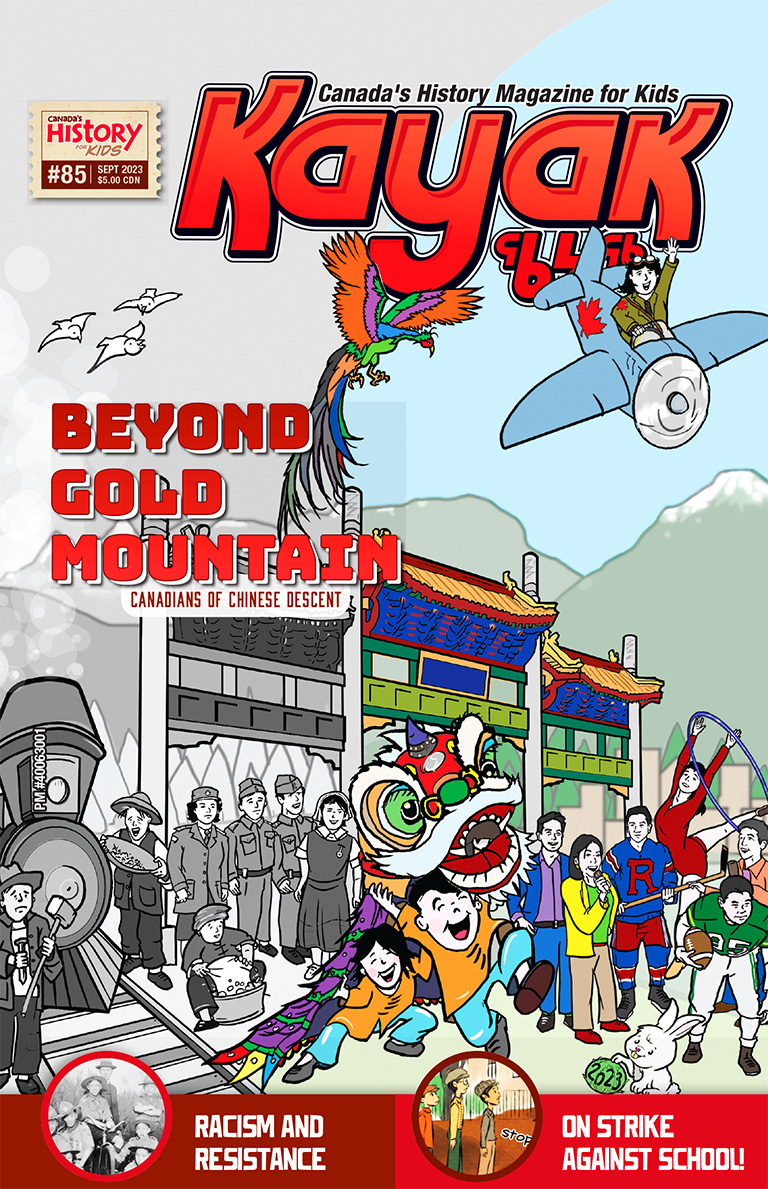Lesson Overview |

Grade Levels: 5/6, 7/8, 9/10 Subject Area: Social Studies, Geography Time Required: 1-2 lessons Magazine Issue: “Beyond Gold Mountain: Canadians of Chinese Ancestry,” Kayak: Canada’s History Magazine for Kids, September 2023 |
In this lesson, students will explore the history of Chinatown and its importance to Chinese immigrants and Canadians of Chinese ancestry. Students will use Kayak magazine and primary sources to gain a deeper understanding of this topic. |
Historical Thinking Concept(s) |
- Establish historical significance
- Use primary source evidence
- Identify continuity and change
|
Learning Outcomes |
Students will…- understand and explain the importance of ethnic enclaves and their contributions to the existence/survival of immigrants.
- gain knowledge of the challenges that face Chinatowns in the past and present.
- examine how Chinatowns have stayed the same and how change has occurred.
|
Background Information |
| Chinatowns and other ethnic enclaves were created to serve as safe havens for new Chinese immigrants. Places to shop familiar food, shared language and similar culture and practices led to the establishment of Chinatowns in almost every major city centre across Canada. Yet, Chinatowns have always been under scrutiny, by the public and government regulations. It is the ongoing work of those living and working in Chinatowns to push back as a form of resistance. |
Resources Required/Teacher Prep |
|
Primary Sources Used |
Warning about the use of language in the Primary SourcesThe language found in many of these primary sources includes terms and images that are considered offensive today. The teacher should review the use of these terms with students that were used in the time period of the primary source and the manner in which they should be treated today. |
Image 23 — "Chinatown outlived Drapeau but it's still fighting city hall"Image 24a/b/c — "City tearing us apart brick by brick"Image 25 — "Plan to create a Chinatown fraught with problems"
|
Lesson Activity |
ACTIVATING- Read pages 12 and 26-27 of “Beyond Gold Mountain.”
- Teacher should define an ethnic enclave and brainstorm/discuss with the class the importance of these areas to new immigrants.
- Teacher can discuss the importance of food culture, language, and the sense of belonging that these communities provide.
- Teacher can ask students to share what cultural places/sites have great importance to themselves and why they hold such importance.
ACQUIRING- Teacher distributes copies or excerpts of the following primary sources to small groups: Image 23, Image 24a/b/c and Image 25. Alternatively, the teacher can read the articles aloud to students. Encourage students to consider why Chinatowns are important and reasons why Chinatowns are declining.
- Combine groups of students who read different articles together to complete Worksheet 5.1. Alternatively, the teacher can fill out the worksheet as a whole class.
- Once students have placed their information, have them choose two colours and sort the reasons for decline — how much of the decline is due to governmental policies and how much of the decline is due to social/cultural reasons?
- Teacher can discuss and debrief the findings of the students.
APPLYING- Using the news article titled “The rise and fall of Chinatown” in its whole or the excerpts provided, have students compare and contrast contemporary opinions from those presented in the articles from the 1980s. Students can look for continuity and change: do the same issues remain? What is the future of Chinatowns? Students can display their work using a Venn diagram.
- Have students read the article titled “What is the future of Chinatown” in its whole or the excerpts provided, and ask them to write a proposal on making the Vancouver Chinatown a UNESCO World Heritage Site. Encourage students to frame their argument using the criteria for selection (linked below).
|
Lesson Alternatives/Accommodations |
| Depending on the strength of the class, the teacher can keep the three pages of the newspaper intact and have students analyze the entire document, or they can read the article aloud for their students. Teacher could also do this activity with the students. |
Materials/Resources |
Additional resources to support this lesson |
Possible Extension Activities |
- Students could use Google Maps and find where Chinatowns are located around the world — and to see the immigration patterns of Chinese people.
- Visit a Chinatown in your local community and see about walking tours.
- Have students pick their favourite dish (can be of their own cuisine) and do some research into the history of its creation.
|
Possible Assessment |
- Observation and feedback for classroom discussions
- Possible formative or summative assessment for the worksheets
|









